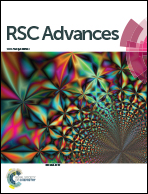Preparation, modification and characterization of polymeric hollow fiber membranes for pressure-retarded osmosis†
Abstract
The present study evaluated the performance of polymeric hollow fiber membranes in the pressure-retarded osmosis (PRO) process for power generation. This study systematically investigated ways to develop a high flux and high power density. The polyethersulfone (PES) membrane support was modified by coating with polydopamine (PDA). After polydopamine coating, the effect of an additive during interfacial polymerization to make a thin film composite (TFC) layer on the polydopamine-coated layer was studied. At the time of interfacial polymerization, we added tributyl phosphate (TBP) as an additive in the organic monomer solution to increase the water flux and power density. The modified membranes were then well characterized by ATR-FTIR, SEM, AFM, TEM, porometry, and contact angle analysis; their performance in salt rejection, water permeability, and power density was evaluated. The relationship between the performance of the TBP additive and the physicochemical properties of the polyamide layers, that is, the free volume, surface roughness and hydrophilicity, seemed very high. The experimental results indicate that the addition of TBP additives changes the retention properties of the composite membrane; a certain concentration of TBP additives retained in the membrane increases the membrane water flux along with power density.


 Please wait while we load your content...
Please wait while we load your content...